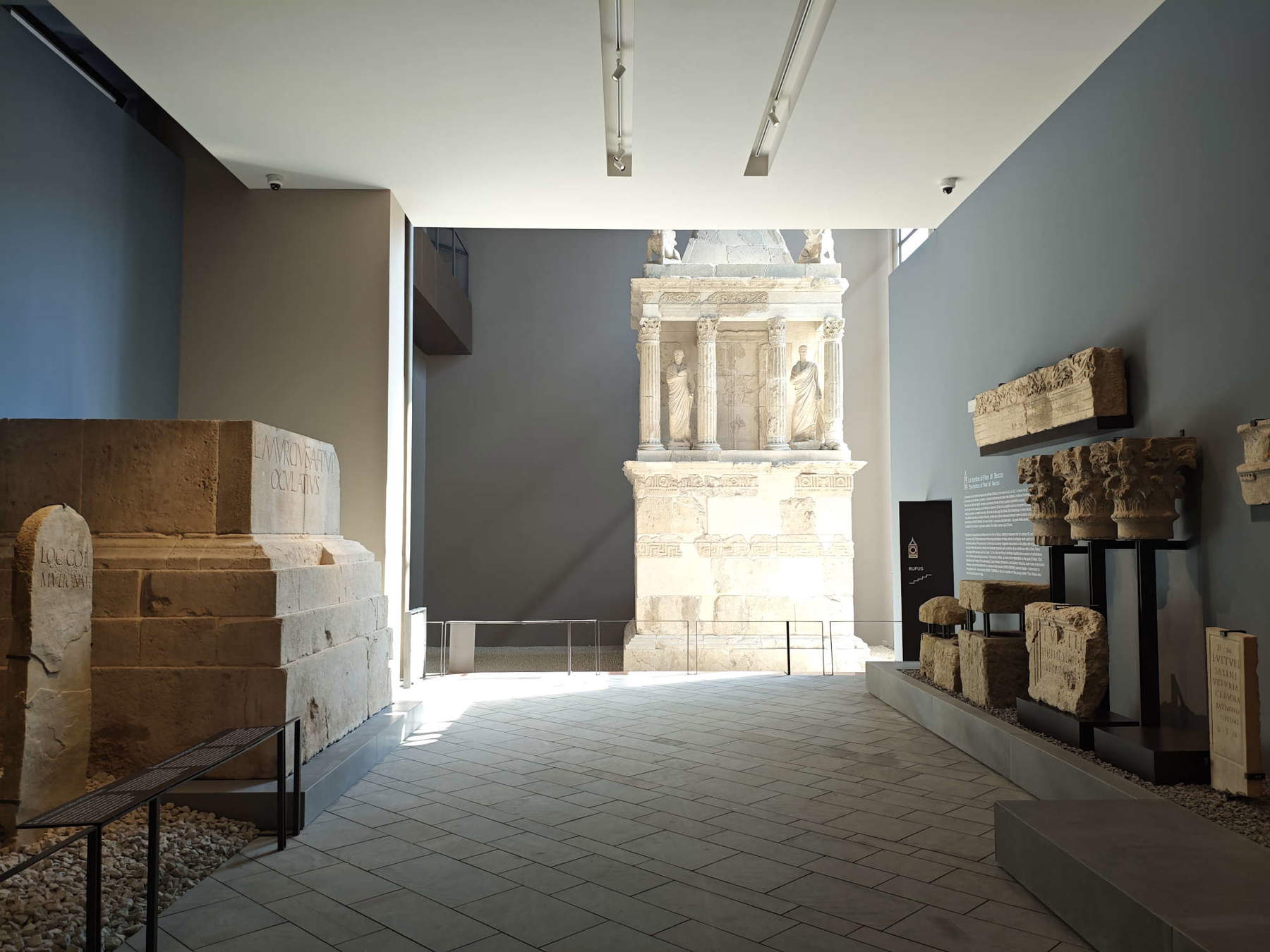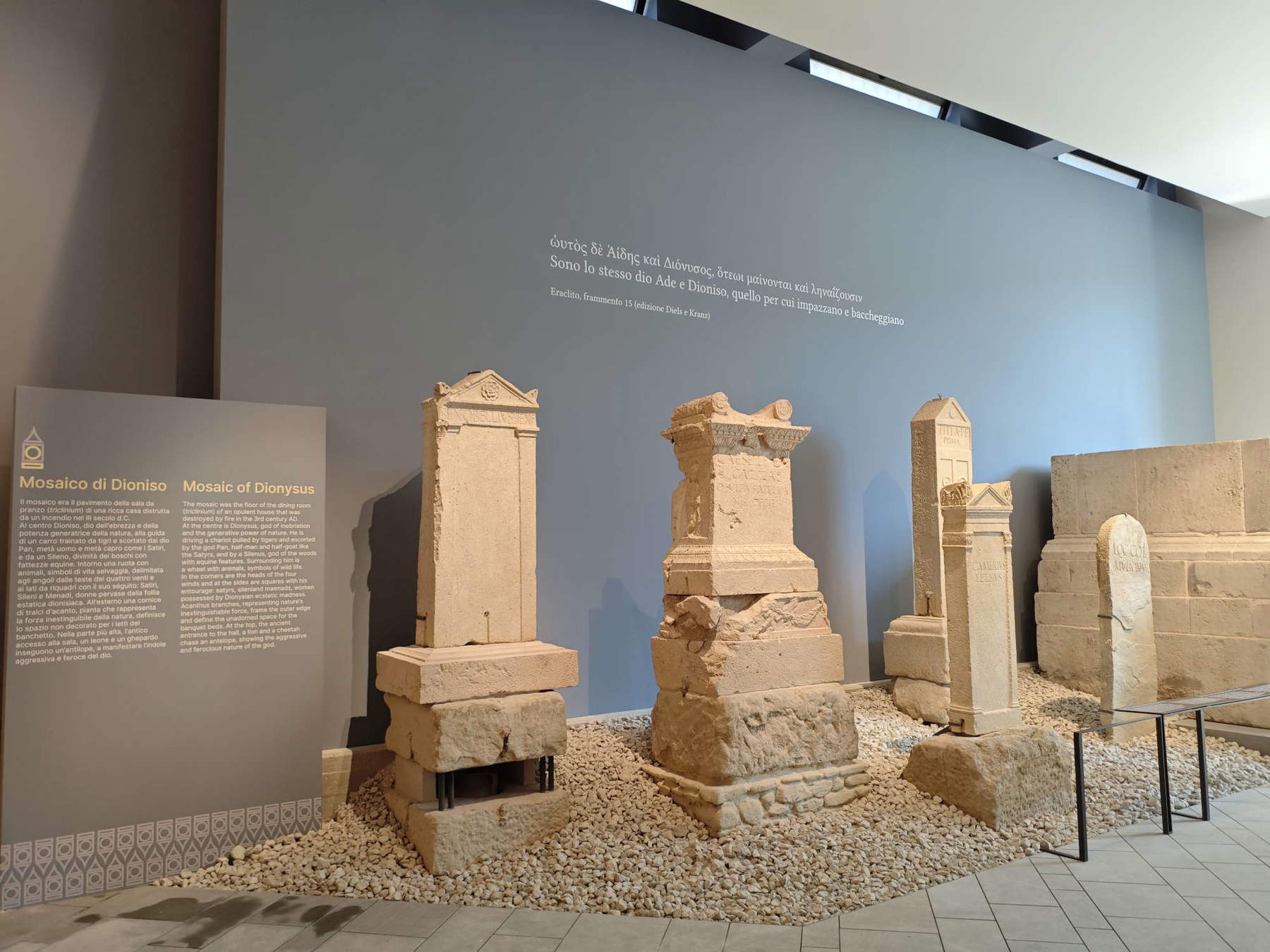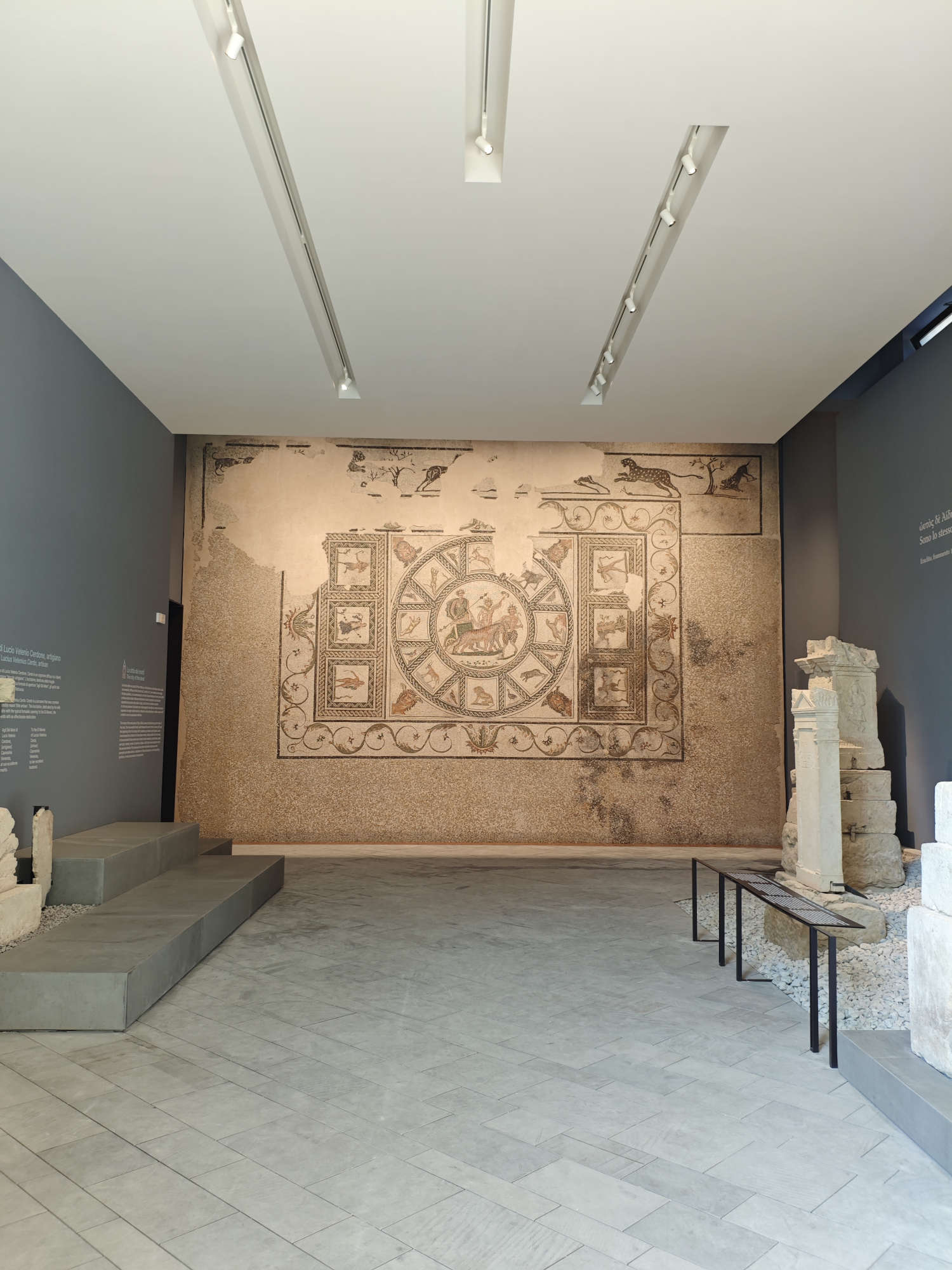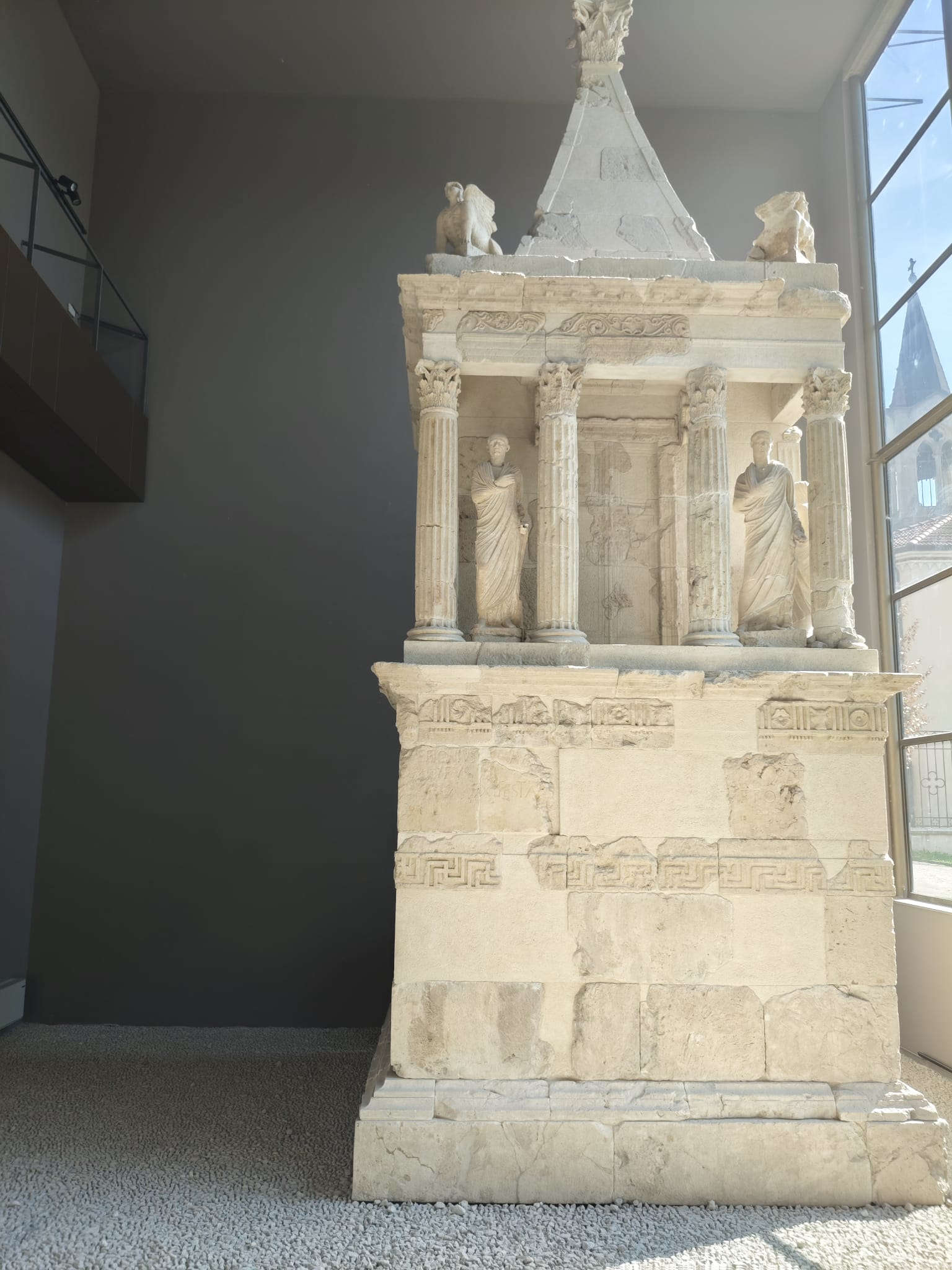After eleven months of closure and a construction site involving more than 1,600 square meters distributed on three levels, the heart of the National Archaeological Museum of Sarsina finally reopens to the public. Starting August 27, visitors will in fact be able to return to admire the monumental Rufus Hall, one of the most representative rooms of the museum complex, which houses two of the most significant finds from the Roman city of Sassina: the great Mausoleum of Rufus and the polychrome mosaic of the Triumph of Dionysus.
The reopening represents the first stage of the museum’s complete refurbishment, which is scheduled for completion between late 2025 and early 2026. Giving new luster to the exhibition itinerary is a complex and articulated project designed to fully enhance Sarsina’s archaeological heritage. The project was coordinated by Maria Lucia Masciopinto, an architect functionary of the National Museums of Bologna for the Regional Directorate of National Museums of Emilia-Romagna, who is also the single project manager.
The completely renovated Rufus Hall now has a contemporary look, where every element-from the light to the geometry of the spaces-has been designed with the idea of putting the artwork in the foreground, favoring its legibility and emotional experience. The architectural project, signed by BALLETTI+SABBATINI architects, was created with the intention of restoring centrality to the works through clear, simple and elegant stylistic choices. The studio has already signed major interventions such as the refurbishment of the Museo Ostiense and the new Archaeological Museum of Capri at the Certosa di San Giacomo.
A central element of the new layout is the lighting design, by architects Carolina De Camillis and Riccardo Fibbi, designed to enhance the funerary architecture and volumes of the Mausoleum. Thanks to the use of projectors placed in multiple directions, with calibrated and diversified beams of light, the monument is highlighted even in the evening hours, visible from the outside through the large window overlooking Lopik Street. In this way, the Mausoleum becomes an integral part of Sarsina’s nighttime urban landscape, giving the town a new visual and cultural landmark. The lighting not only highlights the monumental structure but also replicates the natural light that filters through the windows during the day, giving the rooms a perceptual continuity. In the Rufus Hall, in particular, the play of light is designed to restore depth and monumentality to the Mausoleum, which is more than 13 meters high, making it visible even to those walking outside the museum. The Mausoleum of Rufus is a masterpiece of funerary architecture built at the height of the Augustan Age, from the necropolis of Pian di Bezzo. It is an example of an “aedicule mausoleum,” characterized by a quadrangular base with dedicatory inscription, a median body in the shape of a temple cell with colonnade, and a pyramidal roof surmounted by hybrid mythological figures between sphinxes and harpies. The two male statues on the front and two female statues on the sides enrich the structure, designed to celebrate the status of the deceased and his family. Reconstructed in the 1990s and placed in the present glass hall, the mausoleum dominates the space and welcomes visitors with its imposing bulk. Its height, exceeding 13 meters, and decorative details make it one of the most significant and spectacular exhibits in the museum. The effect it evokes in the visitor is one of wonder and respect, a silent dialogue with the city’s glorious and millennial past.
Alongside the architectural and technological intervention, the new face of the Museum of Sarsina is completed thanks to the contribution of FrameLAB - Multimedia & Digital Storytelling, a laboratory of the Department of Cultural Heritage of the University of Bologna, which has taken care of the new visual identity and visitor supports. The museum experience thus becomes accessible, engaging and narrative-oriented: the refurbishment includes a bilingual itinerary, an audio guide and updated educational apparatus, which will also tell about the city’s most recent archaeological discoveries, such as those in the Capitolium.
The relaunch of the hall is accompanied by a rich calendar of initiatives and cultural events designed to accompany visitors until the museum’s full reopening. Starting August 27, in fact, a series of guided tours and meetings will begin that will enliven the coming months. Highlights include an evening musical event on Sept. 27, on the occasion of European Heritage Days, and a series of meetings entitled “Returning to the Museum,” which will begin on Saturday, Oct. 25, with a conference dedicated to the new layout and ongoing interventions.
The refitting project has seen the scientific contribution of numerous scholars, including Federica Timossi, Romina Pirraglia, Chiara Guarnieri, Elisabetta Govi, Jacopo Ortalli, Paolo Baronio, Patrizia Maria Laura Cirino, Giovanna Patti, Marco Brunetti, Alessandro Iannucci and Simone Zambruno. Restoration and structural consolidation works for seismic improvement were directed by Massimo Mariani. Restoration of the stone surfaces and handling of the works were handled by Elena Arlotti, Chiara Carcano and ETRA S.N.C. The graphic design and visual identity were entrusted to Alessandro Iannucci, Simone Zambruno and Anna Gribovich of the FrameLAB laboratory, while the editing of the texts and captions was the result of a collective work that also involved the scholars involved in the scientific design. Safety in the executive phase was provided by Nicola Pero Nullo. Finally, numerous companies contributed to the implementation of the interventions: Cogen Srl, Grafox Srl, Valeri electric, Nuove Superfici, GSA security systems and Facchini Rimini. Through the Museum’s social channels, it will be possible to follow the evolution of the construction site and stay updated on events and activities.




“The preview presentation of the new lighting of the mausoleum of Rufus,” says Costantino D’Orazio, acting director of the National Museums of Bologna-Regional Directorate National Museums Emilia-Romagna, “is an ’extraordinary opportunity to literally shine a spotlight on a museum with exceptional potential, custodian of a collection that not only offers the opportunity to admire artifacts of great quality and value, but above all tells the story of the origins of a community, that of Sarsina, to which the museum is deeply connected. For this reason, in agreement with the mayor, we decided to organize this event precisely on the occasion of the feast of San Vicinio, patron saint of Sarsina. Resources from the Institute, the General Directorate of Museums and the Department for the Enhancement of the MiC have been used for the installation works alone, for a total of 900,000 euros in addition to what has already been allocated for seismic improvement works (500,000 euros) and the interventions to repair the damage caused by the flood of May 2023 (100,000 euros). We are happy to have started a new history of this museum, which in a few months will be concluded with the reopening of the entire structure and all the rooms, to be at the service of the city and all visitors who want to discover one of the finest, most compelling and well-told collections in the world.”
“I’m very happy to be able to welcome the public back to the Museum after this period of closure,” says Federica Timossi, Director of the National Archaeological Museum of Sarsina, “a year ago we were preparing to shelter and protect the Museum’s artifacts in view of the structural seismic improvement works, designed and directed by engineer Massimo Mariani, and today we will be able to show you the first renovated room: action is being taken overall on the layout, with the aim of making the understanding of the heritage more accessible and engaging, thanks to the fruitful collaboration between the internal professionals of the National Museums of Bologna-Regional Directorate National Museums EmiliaRomagna, a dedicated scientific technical committee, external designers, the Soprintendenza Archeologia Belle Arti e Paesaggio for the provinces of Ravenna, Forlì-Cesena and Rimini and FrameLAB - Multimedia & Digital Storytelling, the FrameLAB - Multimedia & Digital Storytelling research laboratory of the Department of Cultural Heritage, University of Bologna and with the ever-active support of the Municipality of Sarsina.”
 |
| Sarsina, Rufus Hall reopens: the Mausoleum visible even at night from outside |
Warning: the translation into English of the original Italian article was created using automatic tools. We undertake to review all articles, but we do not guarantee the total absence of inaccuracies in the translation due to the program. You can find the original by clicking on the ITA button. If you find any mistake,please contact us.